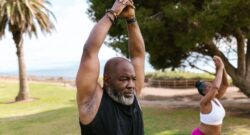Author: admin
HealThy Self Retreat
Peace Family, We doing another round of the Heal(Thy) Self Retreat Puerto Rico April 19-24th. This time around we have special guest speaker- Supreme Understanding! View this post on Instagram A post shared by Maat Village (@maat_village_project) Please check out our IG page @maat_village_project for more details and contact information
An Introduction to S.O.I.L.
SOIL – A New Kind of School! An Independent School teaching: Ancestral Traditions Indigenous Values Entrepreneurship Self-Publishing Natural Science The Science of Self Culinary Arts Yoga and Martial Arts Community Improvement Elder Care and Respect This is what we teach at SOIL, the School of Indigenous Learning – a new experience in education being introduced to Atlanta’s west side by veteran educator Dr. Sujan Dass. Based on two decades of international research, this school teaches its students how to write, produce, and publish their own work, run a small business, and how to grow and prepare their own food – all within a year! How? This is a nontraditional school – teaching the world’s oldest traditions! With LOVE! Opening in September 2021, SOIL will begin by serving its first middle school students. Our class sizes will be small, and we will scale to serve elementary and secondary students over the next two years. We will share many of our lessons and activities online via www.ourbestschools.com School days are from 8 to 3, with an afterschool art program from 3 to 6. Vegan meals are included. Students go on field trips and nature walks weekly, and parents are invited to come! We also work with a great network of guest teachers and artists. We don’t expect parents to pay extra for any of this, but welcome any contributions and volunteers. Everything we do is covered by tuition. Tuition is offered on a sliding scale, but spaces are limited! As this is a dynamic new approach to school, we’re starting our pilot year with a small cohort of students and parents. We’re launching in a beautiful space called The Mosaic Museum (www.themosaicmuseum.com) until our student body grows in future years. Ready for your child(ren) to begin their future? We will begin accepting new student applications soon, both for our first school site in Atlanta as well as our online programs which can be accessed from anywhere! To find out more about our programs and how to enroll your child, visit www.ourbestschools.com
Help us become the leading resource for local news and views
We need great independent journalism centered on issues relevant to the Black/Indigenous Global Diaspora. Help us become the leading resource for local news and views – from around the world – that are independent of mainstream narratives and sponsored views. We want you to become one of the best journalists the future will have seen. We’ll even pay you to get good at it. How? It’s easy! Just login to your account (they’re easy to create – and free – if you don’t have one), pick a blog category, and post an article about a topic you haven’t seen addressed, or a local business that deserves some great coverage in this field. You can also leave community feedback and responses in the comments and discussion areas. Featured blogs will be found on our front page, and may be featured in print and ebook publications. If we include your contributions, we’ll give you full credit and a link to your profile, as well as a gift card redeemable at our growing community of partners, like Supreme Design Publishing, The Solutionary Institute, Proven Publishing, and GoBro Scooters. If you’re a business owner interested in partnering with us, please leave a comment below and we will reach out to you! At The Solutionary Institute, our partner in online (and real-world) education, you’ll find classes on how to research, write, publish, and sell your own work. Feel free to visit and check out that course and others! As we grow, we will be hiring staff writers from our beloved contributors, so we look forward to your future contributions and our continued success together! Peace!
THE CURE FOR THE COMMON COLD
BY SUPREME UNDERSTANDING AND DIVINEGOD B ALLAH Your immune system is your body’s armor when it comes to harmful germs and bacteria. The best way to prevent catching a cold is to have a healthy immune system. Here’s a few easy ways to do that: Get regular exercise, followed by good rest. Drink plenty of fluids, especially water. Wash your hands regularly. Get as much fresh air as you can steal. Minimize your stress. Yoga and Tai Chi are two great forms of relaxation on an ongoing basis. Once you’ve got a cold, there’s not much you can do but fortify your immunities to fight it off. Here’s some advice on that: Ever heard the saying “Feed a fever and starve a cold”? old wives’ tale, right? Well, research by Dutch scientists suggests that eating boosts the type of immune response needed to fight off the common cold virus, while fasting from food promotes a different type of immune reaction necessary to overcome the bacterial infections that trigger most fevers. So it seems like they just had it backwards. You should feed a cold, and starve a fever. No matter what you do, the key is WHAT you eat and drink. When you’re sick, drink plenty of liquids (especially those high in Vitamin C) and eat fresh fruits and vegetables, especially the colorful ones that are high in Vitamins A and C. If you want to starve that fever by only having soup, I recommend a spicy, garlicky vegetable broth over chicken and noodles. Unless the soup is full of garlic, ginger, hot pepper, and vegetables the chicken and noodles isn’t what’s helping anyway! Take some herbs, like those listed below (see Herbs = Medicine by Supreme Understanding). Garlic, ginger, and cayenne make a very effective tea. At the supermarket, you can also find a natural cold and flu remedy known as Airborne. You drop it in some water and it makes an orangey drink that helps quickly boost your immune system. If you can’t make it to the health food store or even the supermarket, here’s a ghetto remedy: A 99 cent bag of Lay’s Flaming Hot chips (the hot pepper opens up the sinuses) and a 20 oz. bottle of 100% orange juice (boosts the immune system). I can’t promise you any results, but it works for me. Herbs that Help Fight Colds and Flu Symptoms Astragalus Celery seed Eucalyptus German Chamomile Goldenseal Licorice root Peppermint Siberian Ginseng Wild yam Colds generally go away in about 7 to 10 days. Many holistic practitioners see the symptoms of a cold as the body’s natural way of eliminating a virus. However, if you have an underlying lung condition, like asthma or emphysema, and you see your conditions going from bad to worse…it’s time to see a doctor. (See “Healing and Treatment.”) Take the above measures to eliminate or prevent a cold. If your coughing and sneezing everywhere, get some fresh air and sun.
Unlock Online and Real World Connections
Welcome to Your Global Local News Network, Modern Melanin, A Voice for the People! Community News – Uncensored – Unfiltered – For the Benefit of Melanin-Rich People Everywhere! Join Modern Melanin! Get Started Today and Unlock Online and Real World Connections! Find the Best Content in Every Field for and by Melanated People! Set Up Your Community Profile Page Upload your profile picture, change your cover photo, and post content on your profile page. Find Networking and Partnership Opportunities In Our Groups Tap in with people who share your passion for special interests and causes. Join Our Forum Discussions Discuss topics that matter to you and gain perspective from all of the world. [button color=”primary” size=”medium” link=”#” icon=”” target=”false” nofollow=”false”]Yes, I Want All THE BEST Content![/button] Think of us as your Righteous Family helping keep you inform on the topics that matter to you the most!
Pop Quiz: Are You Healthy?
Before we jump into the content of this book, we’ve gotta be clear that this process won’t work if you’re not being honest with yourself – in terms of where you’re at and where you need to be. But even the most honest of people don’t necessarily know how “healthy” or “unhealthy” they are, because there’s so much to that whole health thing. So we’re gonna help you learn about yourself. Try the following quiz and see how you score. What have you got to lose? It’s not like somebody’s gonna see your score and laugh cause you’re unhealthy. Unless you and your friends have this same book. Then, they might. Or you might get to laugh at them. Either way, it’s cool because laughter is the best medicine. See, you’re already on your first step to healing! Seriously though, knowledge is half the battle. The other half (more like 7/9ths) is putting in the work once you have the knowledge. You gotta start somewhere, start with this quiz! 1. Do you eat fried foods? a. Less than twice a week. b. Occasionally, but I’m mindful of it. c. Pretty regularly. d. If it ain’t fried, I probably don’t want it. 2. How long would it take you to walk a mile? a. Less than 10 minutes. b. Between 10 and 20 minutes. c. I’d have to take a few breaks, so I’m not sure. d. Why would I walk a mile? 3. When seated with my legs straight in front, I can bend forward at the waist and reach… a. Past my toes. b. Near my toes. c. My shins. d. My knees. 4. I can balance on one foot, extend my arms, and stand still… a. More than 3 minutes. b. 1 or 2 minutes. c. About 30 seconds. d. I’m not even gonna try that and embarrass myself. 5. Do you drink sugary sodas and artificially flavored “juices”? a. Never. It’s real fruit juice, tea, or water for me. b. Rarely. I go for days without having any sugary drinks. c. Sometimes. But I can manage a day without any. d. Often. It would be hard for me to go without them. 6. Do you exercise? a. I could be an athlete or a personal trainer (30 to 60 minutes most days) b. I’m in decent shape, but I’m not ready for the marathon. (About 30 to 45 minutes a few times per week) c. I can help you move out of your apartment, but not by myself! (About 30 minutes twice a week) d. Sometimes I have to walk across a big parking lot. (Very little, if ever) 7. Do you eat sweets or candy? a. What’s a snickerdoodle? (Never) b. Where’s the snickerdoodles? (Rarely) c. I need some snickerdoodles. (Sometimes) d. I am the snickerdoodle. (Often) 8. Do you eat red meat? a. Never. b. Not often. c. At least once or twice a week (or “I eat beef but not pork”) d. They call me “Swinefeld” 9. Do you have breakfast in the morning? a. Yes, daily. And it’s usually pretty healthy. b. Most days. And it’s usually pretty healthy. c. Most days. But it’s usually not that healthy. d. Does a cup of coffee count? 10. Do you smoke? a. No, and I never have. b. I used to smoke, but I quit. c. I don’t smoke, but I live with or work around smokers who puff near me. d. All day. Nicorette ain’t got a patch strong enough for me. 11. When was the last time you had your blood pressure and cholesterol checked? a. Within the past year. b. Within the past two years. c. Several years ago. d. I can’t remember. 12. How much sleep do you get at night? a. 6 or 7 hours a night. b. 8 or more hours a night. c. Less than 6 hours a night. d. My sleep patterns are so irregular I couldn’t even tell you. 13. Do you use any “recreational” drugs? a. Nope. I get high off my success. b. I might smoke a little weed on occasion, but that’s it. c. I might do a little bit more than weed. d. I could be considered a junkie, if you were trying to be mean. 14. How is your dental health? a. My dentist worships me. b. I haven’t seen the dentist in a while, but I brush and floss regularly and I don’t have cavities. c. I don’t brush or floss like I should, and I probably have a few cavities I need to address. d. I’m probably gonna lose some of these teeth. 15. How much sunlight do you get? a. If I was white, I’d have an awesome tan. b. I get at least an hour of sunlight daily. c. I’m stuck indoors most weekdays, but I try to make up for it by getting some sun on the weekends. d. I’m practically a vampire. I can remember the last time I spent a while in the sun. 16. How much water do you drink? a. All I drink is water (More than 64 ounces). b. 8 glasses a day, like the doctor say (48-64 ounces). c. I don’t drink as much as I should (16-48 ounces). d. There are too many other things that taste better (0-16 ounces). 17. How do you deal with illnesses? a. I know how to cure most things naturally and who to see when I don’t. b. I consult with a healthcare professional and develop a regimen that will combat the illness. c. I see a doctor and hope he knows how to fix me. d. I pop some pills, say a prayer, and hope for the best. 18. What kind of medicines do you take? a. Mostly herbs, minerals, and whatever else Mother Nature provides. b. Mostly natural stuff, but I use the synthetic stuff too. c. Mostly the synthetic chemical stuff, but I’ve been trying natural remedies too. d. Mostly pills, needles, and whatever else Medicaid provides. 19. Do you have mood swings or rapid emotional changes? a. No way. That’s crazy as hell. b. It’s rare, but it happens. c. More than I’d like to admit. d. All day. I’m crazy as hell. 20. When is the last time you fasted or did a cleanse? a. Within the past month. b. Within the past six months. c. Within the past year. d. The only detox I know about is the one you do for a urine test. 21. How often do you get headaches? a. Rarely. b. Sometimes, but I usually know what caused it. c. Often, and they can get bad. d. I got one right now, and I’ll probably have another one soon. 22. How often do you eat fresh or steamed vegetables? a. At every meal b. At most meals c. Not often…does rice and peas count? d. Um…do the tomatoes in ketchup count? 23. When was the last time you had your stuff inspected? (Pap smear, STD test, breast exam, testicular exam, prostate exam) a. Within the past two years. b. Three or four years ago. c. Five or more years ago. d. I ain’t doin none of that nasty stuff. 24. How often do you treat pains with an over-the-counter pain reliever? a. I take one once or twice a year, or I used a natural remedy. b. I use them occasionally. c. I pop a pain reliever most days. d. Over the counter? Please. Gimme that Vicodin baby. 25. How much alcohol do you drink? a. I average one drink or fewer per day. b. I drink once in a while, but then I’ll often have four or more. c. I have about two drinks daily. d. I average more than two drinks a day; at times I can’t remember how much I drank or what I did afterward. 26. What do you eat more of, pastries or fruit? a. All fruit, no pastries or sweets. b. More fruit than pastries and sweets. c. More pastries than fruit. d. Mostly pastries and sweets, almost no fruit. 27. What’s your waist size? a. Less than my hips b. Bout the same as my hips c. A little more than my hips d. C’mon son! I’m FAT. 28. Do you have a family history of heart disease, diabetes, cancer, or other hereditary illnesses? a. No parents or grandparents with any problems like that. b. 1 or 2 of my parents or grandparents have 1 or 2 problems like that. c. Most of us got something. d. Everybody’s got something, and some of us got everything. (or “I have no idea”) 29. Which best describes your sexual practices? 30. I’m in a long-term, mutually monogamous relationship. a. I’m not committed to one person; but I always use condoms when I have sex. b. I’m not committed to one person; and I don’t always use a condom. c. I get it in, by any means necessary. 31. How do you typically cope with stress? a. I regularly carve out time to recharge. b. I vent about my crises to a friend or a family member. c. I don’t know what to do. Usually I just feel overwhelmed. d. I depend on alcohol, food or another vice to help me make it through the day. 32. I experience fatigue… a. Only after a strenuous workout or similar physical activity (ahem). b. Usually after a long day of work c. After climbing a set of stairs, taking a long walk, or carrying something heavy d. Pretty much throughout the day, even when I haven’t done anything 33. I experience back or muscle pain… a. Never. b. Sometimes. c. Pretty often. d. I stay with some kind of pain. 34. When I stand against the wall… a. The back of my head, hips, feet, and shoulder blades touch the wall. b. Only the back of my hips, feet and shoulder blades touch the wall. I have to change my posture for my head to touch the wall. c. Only the back of my hips and feet touch the wall. I have to change my posture for my shoulder blades to touch the wall. d. Only the back of my hips touches the wall. I don’t want to talk about it Scoring Scoring Key Items Marked Points A: 0 points Number of As: ____ x 0 = ____ 0 B: 1 point Number of Bs: ____ x 1 = ____ C: 2 points Number of Cs: ____ x 2 = ____ D: 3 points Number of Ds: ____ x 3 = ____ TOTAL SCORE = Scoring Ranges and Explanation 0-10: OPTIMUM You’re either insanely healthy or just plain insane. Most people are nowhere near this level of optimum health, so we congratulate you (if you’re telling the truth). If you lied, you may need to skip ahead and go straight to the section on psychological health, because that’s just strange. Assuming that you were being truthful, you’re a living example of the principles in this book. Because of how much information we’ve packed into the following pages, we’re sure you’ll still learn a lot. But you’ll find this text most valuable if you use it as a teaching tool for the people you know who need it more than you. 11-25: EXCELLENT A great score. You should be proud. You eat healthy, live healthy and probably even think healthy. Sure, there are some things you could work on, but with this book, you’re definitely on the right track to optimum health and a long, satisfying life. 26-50: DECENT Even with a score in this range, you’re still doing better than most Americans. But if you think about it, that’s not necessarily a high standard to measure yourself against. Perhaps you need to eat more fruits and vegetables and less junk. Perhaps you should be exercising more and spend less time indoors. Perhaps you should go see a doctor or a dentist soon. Whatever the case, you have plenty of room for improvement, and this book will make sure you cover it all. 51-75: UNHEALTHY Don’t be offended at being called “unhealthy.” We’re just being real with you. You knew you weren’t too healthy when you took this quiz, so don’t be mad at us for telling you what you already know. The question now is ‘What am I going to do about it?’ You can either continue on the downward spiral of unhealthy living, cut several years off your life, and finally end up dead before your time or sick and miserable in your old age…OR you can get on the upward spiral to better living. It’s your choice. You have family members who chose not to address their health until it was too late. You’ve seen what happens. It’s going to be some work, but this book will guide XE “Tips” you through many of those changes, showing you both the big steps and the baby steps you can take. Aren’t you tired of feeling the way you do? Make a decision. Your bad habits can still be changed! 76-90: SICK You’ve got a LOT of unhealthy habits. You know you do. You’ve been treating your body like a rental car you don’t plan on returning. But it’s all gonna get billed to you in the end. You pay for all those habits, one day, some way. And it’s never pretty. In your present condition, you’re probably already sick. You may have diabetes, cancer, arthritis, heart disease…who knows? You may not even know what you have. But unless you’re going to kill yourself now, you should consider this 91-100: DEAD Seriously? How do you even get a score in this range? I know crackheads who would score higher. Either you were trying to be funny when you took this quiz, or you’re an unhealthy crackhead. You can’t even get 100 points on this quiz. It’s mathematically impossible. Just like it’s almost physically impossible to live much longer with the type of lifestyle you have, if you scored in this range. If you really scored between 91 and 99, this book could literally save your life. The first step is knowing you can improve. Then you apply solutions.
Vaccinations 101 By Queen Zafirah Aqueous (Hood Health Vol 2 Excerpt)
What is a Vaccine? “A vaccine is a medical preparation providing immunity from a vaccine specific disease….vaccines change the immune system by promoting the development of antibodies that can quickly and effectively attack a disease causing microorganism when it enters the body, preventing disease development.” – The Gale Encyclopedia of Science “Valence” is a term used to describe how many different viruses or strains of viruses the vaccine is designed to immunize against. For example, a trivalent influenza vaccine is designed to immunize against two strains of Influenza type A and one strain of Influenza type B. Live, attenuated vaccines, like the MMR, are very commonly used. They are vaccines that are alive and infectious but have been treated with a chemical (often formaldehyde) that is supposed to weaken them to the point that they do not actually because the disease against which they are immunizing. They can multiply and are more effective unlike killed/inactivated vaccines. Some vaccines, such as the DTaP vaccine, contain portions of the microorganism attached to a chemical that allows it to stimulate the immune system. What’s in a Vaccine? Formaldehyde, other animal viruses, cow blood, traces of human DNA, MSG, heavy metals like mercury and aluminum, disinfectants, antibiotics, sugar, gelatin, egg. The common disinfectant used in vaccines is both cancer causing and toxic. Shockingly, the chickenpox vaccine involved the use of a cell line that was started using tissue from human embryos obtained through illegal abortions in the 1960’s. Some research has been done implicating the SV 40 virus, a monkey virus, which was not removed from some vaccines during cleaning, in cancer cases. What are some diseases that we currently vaccinate against? r Measles, mumps, rubella (MMR) r Diphtheria, pertussis, tetanus (DPT) r Human papilloma virus (HPV) r Influenza r Chickenpox/Varicella r Polio r Hepatitis r Hib (Haemophilus influenza, type b) Why Vaccinate? r Some of these diseases can be fatal. It gives parents peace of mind by helping to shelter their children from preventable illness and potential death. Conditions in schools make it easier for children to transmit pathogens as do some crowded living situations. Babies have immature immune systems and it is seen that giving them some immunity protects them. In some countries, it is easier to contract illnesses with less access to effective medical care. Some diseases are worse when contracted as an adult. Rubella, for instance, isn’t a very serious illness on its own, but can lead to a disorder called congenital rubella syndrome (CRS) when contracted by a pregnant woman. CRS can lead to serious birth defects and sometimes death of the child. Chickenpox is also more serious in adults. Thus, it is better to intentionally expose children to vaccine preventable diseases. Some public assistance programs require recipients to vaccinate their children for full benefits. The Illness and the Vaccine With certain vaccines, the risks associated with being infected are similar to being injected with the vaccine. It seems that, as well as presenting the risks of a natural infection, vaccines also introduce other potential complications. Both the measles illness and measles vaccine are associated with brain inflammation, seizures, hearing loss, and the development of irritable bowel disorder. Specific only to measles vaccination is the risk of experiencing atypical measles infection. An atypical infection is a more severe case of measles striking only those that have been previously vaccinated. The risk of death is higher in atypical measles infections than in natural infections. Mumps and its vaccine share the potential of aseptic meningitis. The mumps vaccine alone is associated with the development of insulin dependent diabetes. Both rubella and its vaccine can lead to arthralgia or arthritis. There is a possibility that children who were vaccinated for chickenpox will develop shingles as an adult. Aviva Romm, in Vaccinations: A Thoughtful Parent’s Guide: How to Make Safe, Sensible Decisions about the Risks, Benefits, and Alternatives, suggests that the diphtheria, pertussis and tetanus (DPT) vaccine is associated with a significant number of frequently occurring adverse reactions. These reactions seem to outweigh the discomforts common to a natural infection. Pertussis and its vaccine may both cause encephalitis. Why not Vaccinate? It’s hard for anyone to tell how safe vaccines are, despite the soundness of the fundamental idea of how vaccines work. In the 1930s, a vaccine for the poliovirus was administered to patients and it caused the paralysis it was designed to prevent. More recently, the CDC changed their recommendation from the oral poliovirus vaccine to the inactivated polio vaccine after studies showed that all polio cases since 1980 were caused by the vaccine. Additionally, Curtis Cost, in his book Vaccines are Dangerous, has collected evidence that some of the illnesses that vaccines have been created for were declining prior to administration of the vaccines. A 1991 study published in the Lancet showed correlations between hepatitis B vaccines and central nervous system problems. Another study in the Lancet found that children who received a new measles vaccine died in significantly greater numbers from common childhood diseases than children who did not receive the vaccine. Another Lancet study found that people who were vaccinated were 3 times more likely to develop Crohn’s disease and more than twice as likely to develop ulcerative colitis. Current research is focusing on the H1N1 Vaccine and the seasonal influenza vaccine (also known as the “flu shot”), with most of the current concern focusing on the mercury content (and possible links to Alzheimer’s) and their role in weakening the immune system (rather than strengthening it). Did You Know? The Swine Flu Epidemic of 1976 inspired the vaccination of over 40 million people. A little known fact was that those vaccinations caused devastating side effects to over 4000 victims. Swine flu itself only killed one person. Harris Coulter, in his book Vaccines, Social Violence and Criminality: The Medical Assault on the American Brain says that much developmental impairment trace back to cases of encephalitis which, Coulter says, are primarily caused by the childhood vaccination programs in industrialized countries. Death and encephalitis have been reported as adverse effects of the MMR, DTP, polio and flu vaccines. Just how necessary are some vaccinations? In her 2010 article, “Using Fear and Prejudice to Attack Vaccine Exemptions,” Barbara Loe Fisher mentions polio-vaccinated children expose unvaccinated children to the poliovirus because they become infectious after receiving the vaccine. Sometimes reactions can also be fatal. The National Childhood Vaccine Injury Act, using your tax dollars, has given money to families of infants who have passed because of the pertussis vaccine. These deaths were originally classified as SIDS deaths. It has been a long time question of my own if vaccines are as necessary as the profits reaped by pharmaceutical companies as well as the Centers for Disease Control (CDC) which is responsible for purchasing and distributing a large number of childhood vaccines. According to Money magazine, a safer form of the pertussis vaccine, a cellular pertussis vaccine, was withheld from the public for years after it was licensed, for reasons of production costs.[1] There are risks associated with taking the vaccines such as allergic reactions and certain syndromes like Guillain-Barre Syndrome (GBS). GBS has symptoms of muscle weakness and paralysis that can cause respiratory dysfunction that may be fatal. Seemingly the symptoms are caused by nerves outside of the central nervous system losing their covering (myelin). A known risk for many vaccines is destruction of the covering of nerves. Myelin is necessary for normal brain and neurological function. The development of allergies and bowel problems are known to be increased when vaccines are given. Since breastfeeding gives newborns immunity passing it from mother to child in the breast milk it may not be necessary to immunize newborns. Breast milk also contains chemicals that protect babies from infections like Hib, pneumonia and other respiratory and intestinal infections along with promoting the maturation of the immune system. Some practitioners see that vaccinating prevents diseases that help the immune system mature thus vaccinations cripple the immune system later on in life. Some practitioners even see that aside from physiological maturity, mental maturity also occurs during an illness. Did You Know? Combination vaccines overwhelm the immune system – it is highly unlikely that a person would get measles, mumps, and rubella all at the same time. What do I do if I want to abstain from vaccination? There are 3 types of exemptions: Philosophical, Medical, and Religious. Look at the National Vaccine Information Center (NVIC) website (www.909shot.com) to investigate the type of vaccination exemptions your state allows and file one. There may still be issues with your child entering or remaining within the public school system. Go to the NVIC site for more information and resources and on how to obtain assistance. What if I want to vaccinate? Some pharmaceutical companies list age ranges for which the vaccine is intended. DPT shouldn’t be given to children over 7 years old. Find out the specifics of the vaccine product (drug name and manufacturer) your doctor will use and research it at the pharmaceutical company’s website or a site like rxlist.com or drugs.com Risk of anaphylaxis is a reality for all shots, so be sure that a chemical used to treat such a reaction, epinephrine, is present at the time of injection. If your child does suffer a bad reaction to a shot, be sure that it is reported to VAERS, after doing all you can to ensure your child’s safe recovery. It is also important to keep detailed records of any adverse events. Whether or not to vaccinate is a very serious issue for many families and, in my research, journalists, holistic practitioners and even medical doctors concur that being informed is crucial in making decisions about whether or not to vaccinate. Fear should not be your primary motivating factor. However, fear is instilled in the readers of much of the literature provided by the CDC, National Institutes of Health (NIH), the public school system and various initiatives whose objective is to increase vaccination. On the other end, fear is propagated by those who oppose vaccines leaving parents in a difficult position. Ultimately, the decisions are made for indecisive caregivers by mandates of the public school system, pressure by doctors, and persecution by vaccinating parents. Research is crucial to making a decision. Please start by reading some of the literature I’ve cited here. The most strategic starting point is a book I’ve consulted throughout this article, Vaccinations: A Thoughtful Parent’s Guide: How to Make Safe, Sensible Decisions about the Risks, Benefits, and Alternatives by Aviva Romm. She offers a wide scope of bare-bones information about vaccines and multiple considerations while not invoking the fear many writers do. Other books on the subject include A Shot in the Dark by Harris L. Coulter, The Parents’ Concise Guide to Childhood Vaccinations: From Newborns to Teens, Practical Medical and Natural Ways to Protect Your Child by Lauren Feder, and What Your Doctor May Not Tell You About Children’s Vaccinations by Stephanie Cave. As a parent, you have a right to decide whether your children are vaccinated and when. Check out the following sites for more: njvaccinationchoice.org, www.cfic.us, and www.vaccinechoice.org Don’t be discouraged. Don’t feel alone. There are many parents all over the world that share this struggle. I’m one of them. Visit the National Vaccine Information Center website to find information on vaccines your child has taken or is “required” to take. [1] Romm seems to think that the acellular version of the pertussis vaccine appears to be safer than whole cell pertussis in some populations because those populations vaccinate children later in life.
Vaccines and Population Control?
By Supreme Understanding The Bill and Melinda Gates Foundation recently hosted a presentation on how ultrasonic frequencies could be used to sterilize men from a distance. Yes, you read that right. I can only imagine how they would use that…and who they’d use that against. Doesn’t sound like something “good guy” Bill Gates would be into? You have no idea. In addition to this sterilization program (which would use sharp blasts of ultrasound directed against a man’s scrotum to render him infertile as a sort of “temporary castration”), the foundation also funded a new “sweat-triggered vaccine delivery” program based on “nanoparticles that penetrate the skin through hair follicles and burst upon contact with human sweat to release vaccines.” According to Gates, he’s raising money to develop vaccine programs “designed to protect children in developing countries from various diseases, including tetanus.” But the Gates tetanus program bears striking resemblance to another tetanus program that sterilized thousands of women and caused abortions in many others in the Philippines. (As reported by the BBC in conjunction with the Philippine Department of Health and the Philippine Medical Association, women in child-bearing years were given a vaccine that was combined with a chemical known as Human Chorionic Gonadotropin (HCG), an anti-pregnancy agent.). But why sterilize people? At a February 2010 TED conference, Gates talked about reducing CO2 emissions worldwide, by limiting population growth. He said: The world today has 6.8 billion people. That’s headed up to about nine billion. Now if we do a really great job on new vaccines, health care, reproductive health services, we could lower that by perhaps 10 or 15 percent! This “population elimination” idea may sound similar to the “conspiracy theories” about the spread of HIV in Africa (which led Nobel Peace Prize laureate and environmental activist Wangari Maathai to charge that “AIDS is a biological weapon manufactured by the developed world to wipe out the Black race” although he later denied such sentiments), but the connections between the spread of smallpox vaccines and HIV in Africa were just one of many cases where Western vaccines (or other medicine) brought hidden problems with them. As recently as 2004, pharmaceutical scientist Dr. Haruna Kaita was contracted by an Islamic body to check out polio vaccines being administered by the WHO in Nigeria. After extensive and repeated tests carried out using state-of-the-art facilities in India, a shocked Dr. Kaita reported that the vaccines were laced with contaminants, some toxic and some having “direct effect on human reproductive system.” But why sterilize people in poor countries? Sterilization, eugenics, and population control all go hand-in-hand. It’s all about controlling who is here in 100 years. And it’s been going on for quite some time. In 1798, Thomas Malthus published An Essay on the Principle of Population, describing his theory on how population growth will exceed earthly resources to provide food for all people. We now know that there is certainly enough food (and land) on the planet to feed everyone, and that hunger is a result of poverty and other forms of social inequity, not simply “too many people.” In fact, many European nations have 10 times more people than your average African nation with twice the land. Also, when you factor in the amount of resources it takes (fossil fuels, land, water, etc.) to feed people on a meat-heavy over-indulgent Western diet, that’s very different from what the rest of the world needs to survive. Soon after the US State Department published the Global 2000 Report for the President in 1980 advising that the world population must be reduced by 2 billion people by the year 2000, Thomas Ferguson of the State Department Office of Population Affairs, Latin American Desk, elaborated: There is a single theme behind all our work – we must reduce population levels. Either governments do it our way, through nice clean methods, or they will get the kinds of mess that we have in El Salvador, or in Iran or in Beirut. Population is a political problem. Once population is out of control, it requires authoritarian government, even fascism, to reduce it…Our program in El Salvador didn’t work. The infrastructure was not there to support it. There were just too goddamned many people…To really reduce population, quickly, you have to pull all the males into the fighting and you have to kill significant numbers of fertile age females…The quickest way to reduce population is through famine, like in Africa, or through disease like the Black Death. Does this put everything in perspective for you? Does it help you understand why Gates would fund something like the programs above? Does it change the way you see all those wonderful agencies doing “healthcare” in developing countries? (Not all, of course, because there are many smaller groups that have good intentions) Does it make you think about what similar agencies are doing (and have already done) with the Black and brown communities of THIS country? Does it make you take a fresh look at why they push birth control and abortion so hard in the hood, while putting fertility clinics and sperm banks in white neighborhoods? Does it make you wonder what this rush to “stop global warming” is really about, since they’re trying to “save the planet” while getting rid of most of the people on it? As we’ll explain in depth in Chemical Genocide, this new wave of environmentalism is NOT centered on the interests of Original people. In fact, most of its strongest advocates are all FOR wiping YOU off the planet. Here are a few more quotes to think about: “Malthus has been vindicated, reality is finally catching up with Malthus. The Third World is overpopulated, it’s an economic mess, and there’s no way they could get out of it with this fast-growing population. Our philosophy is: back to the village.” – Dr. Arne Schiotz, World Wildlife Fund Director of Conservation, 1984 “The biggest problems are the damn national sectors of these developing countries. These countries think that they have the right to develop their resources as they see fit. They want to become powers.” – Thomas Lovejoy, vice president, World Wildlife Fund U.S.A., 1984 “If we look at things causally, the bigger problem in the world is population. We must set a ceiling to human numbers. All development aid should be made dependent on the existence of strong family planning programs.” – Sir Peter Scott, chairman, World Wildlife Fund U.K., 1984 I used to get mad about those commercials pushing the plight of the polar bear, and after seeing the quotes above, I understand why. There’s more: “It will be impossible to feel that the world is in a satisfactory state until there is a certain degree of equality, and a certain acquiescence everywhere in the power of the World Government, and this will not be possible until the poorer nations of the world have become…more or less stationary in population…If there is not to be an endless succession of wars…this will probably have to be done, in many countries, as a result of governmental measures. This will require an extension of scientific technique into very intimate matters.” – Bertrand Russell, The Impact of Science on Society, 1952 “What would it take to accelerate fertility decline in the least developed countries?” – March 2009 U.N. Population Division policy brief “Frankly, I had thought that at the time Roe was decided, there was concern about population growth and particularly growth in populations that we don’t want to have too many of.” – U.S. Supreme Court Justice Ruth Bader Ginsburg “It now remains for the U.S. government to set a sensible example to the world by offering a bonus or yearly pension to all obviously unfit parents who allow themselves to be sterilized by harmless and scientific means. In this way the moron and the diseased would have no posterity to inherit their unhappy condition. The number of the feeble-minded would decrease and a heavy burden would be lifted from the shoulders of the fit.” – Margaret Sanger, Founder of Planned Parenthood, 1926 “All children who are born, beyond what would be required to keep up the population to a desired level, must necessarily perish…Therefore…we should facilitate…the operations of nature in producing this mortality; and if we dread the too frequent visitation of the horrid form of famine, we should sedulously encourage the other forms of destruction, which we compel nature to use. Instead of recommending cleanliness to the poor, we should encourage contrary habits. In our towns we should make the streets narrower, crowd more people into the houses, and court the return of the plague. In the country, we should build our villages near stagnant pools, and particularly encourage settlement in all marshy and unwholesome situations. But above all we should reprobate specific remedies for ravaging diseases; and restrain those benevolent, but much mistaken men, who have thought they are doing a service to mankind by protecting schemes for the total extirpation of particular disorders.” –Malthus, An Essay on the Principle of Population, 1798 And one more, in case you’re unclear as to whom these undesirable people are: “The white population of the world will soon cease to increase. The Asiatic races will be longer, and the negroes still longer, before their birth rate falls sufficiently to make their numbers stable without help of war and pestilence. Until that happens, the benefits aimed at by socialism can only be partially realized, and the less prolific (child-bearing) races will have to defend themselves by methods which are disgusting even if they are necessary.” – Bertrand Russell, The Impact of Science on Society, 1952 Be less trusting of what organizations, corporations, and even some doctors about what you should put in your body. What Can I Do About All This? You may have never heard of it, but the President’s Cancer Panel, which reports directly to the president – just released a new report on these chemical toxins we’ve been describing in this chapter. The landmark report[1] evaluates current scientific evidence and the positions of over 40 experts, and concludes that public health officials have “grossly underestimated” the role environmental contaminants may be playing in the 1.5 million Americans who are diagnosed with cancer each year. The report called for stricter regulations on chemicals and safer alternatives, especially noting that these toxins are most dangerous to young children and unborn babies. In this government-issued report, they actually admit that today’s babies are “pre-polluted” with over 300 different chemical contaminants found in the umbilical cord blood of newborn babies! Let me repeat: These were not weirdoes and conspiracy theorists. These are mainstream, highly-respected scientists (the head of the panel is a Black man!) saying this. I hope that’s not what you needed to hear to take us seriously, but if you did, there you go. So what do you do? Here are the President’s Cancer Panel’s recommendations (from pages 145-147 of the report) for what you can do to protect yourself and your family. Choose foods, house and garden products, play spaces, toys, medical tests, and medicines that will minimize your kids’ exposure to toxic chemicals. (This means eating organic as much as possible and buying products that you know to be free of BPA, phthalates and other endocrine disruptors.) Eat meat produced without antibiotics and added growth hormones. Avoid or minimize consumption of processed, charred, and well-done meats to reduce exposure to carcinogenic heterocyclic amines and polyaromatic hydrocarbons. If you’re pregnant or thinking about it: Both mothers and fathers should avoid exposure to endocrine-disrupting chemicals and known or suspected carcinogens prior to a child’s conception and throughout pregnancy and early life, when risk of damage is greatest. Take off your shoes when you enter your home, especially if you work with or around chemicals. (Wash work clothes separately from other laundry.) Filter your tap water. And continue to choose tap water over commercially bottled water. (See, “BPA Can Make You A New Man.”) Store food and water in containers made from stainless steel, glass, or BPA- and phthalate-free plastic. Don’t microwave in plastic, since chemicals can leach into food when it’s heated. (See, “Plastic Poisons.”) Stop using chemical fertilizers and pesticides on your garden to keep these chemicals from contaminating drinking water supplies. Properly dispose of medications, household chemicals, paints and other materials to minimize drinking water and soil contamination. Turn off lights and electrical devices when not in use to reduce your exposure to petroleum combustion by-products. Drive a fuel-efficient car, bike or walk when possible, or use public transportation to cut the amount of toxic auto exhaust in the air. Wear a headset when you use your cell phone, keep calls brief, and text instead of calling when possible to reduce your exposure to electromagnetic energy. Have your home’s radon levels tested periodically. Avoid second-hand smoke. (And don’t smoke yourself. Duh.) Talk to your doctor about the need for tests or procedures that involve radiation exposure and keep a record of all imaging or nuclear medicine tests received and if known, the estimated radiation dose for each test. Wear sunscreen and UV-protective clothing. (See “Skin Cancer is NOT Prejudiced”) Tell your Congressperson to support the Safe Chemicals Act of 2010, which would overhaul the riddled-with-loopholes Toxic Substances Control Act of 1976. Organize and educate people in your community about what’s happening. Add many of these steps to your daily routine. Convince the people in your household of how important this is. [1] http://deainfo.nci.nih.gov/advisory/pcp/pcp08-09rpt/PCP_Report_08-09_508.pdf







